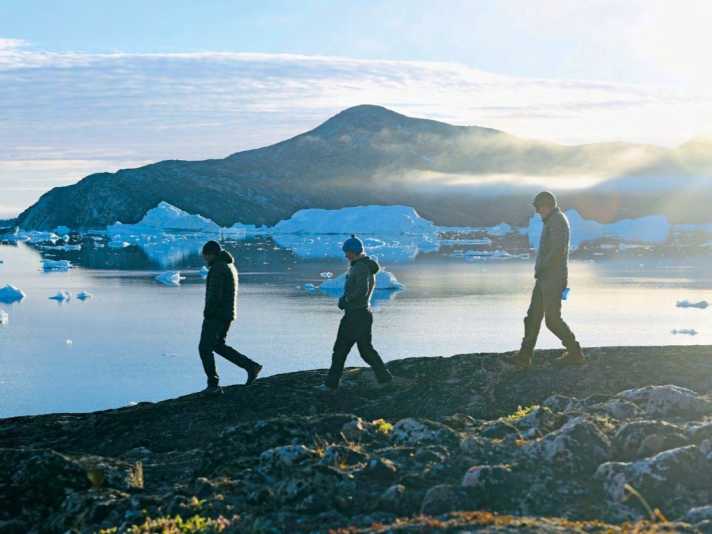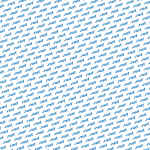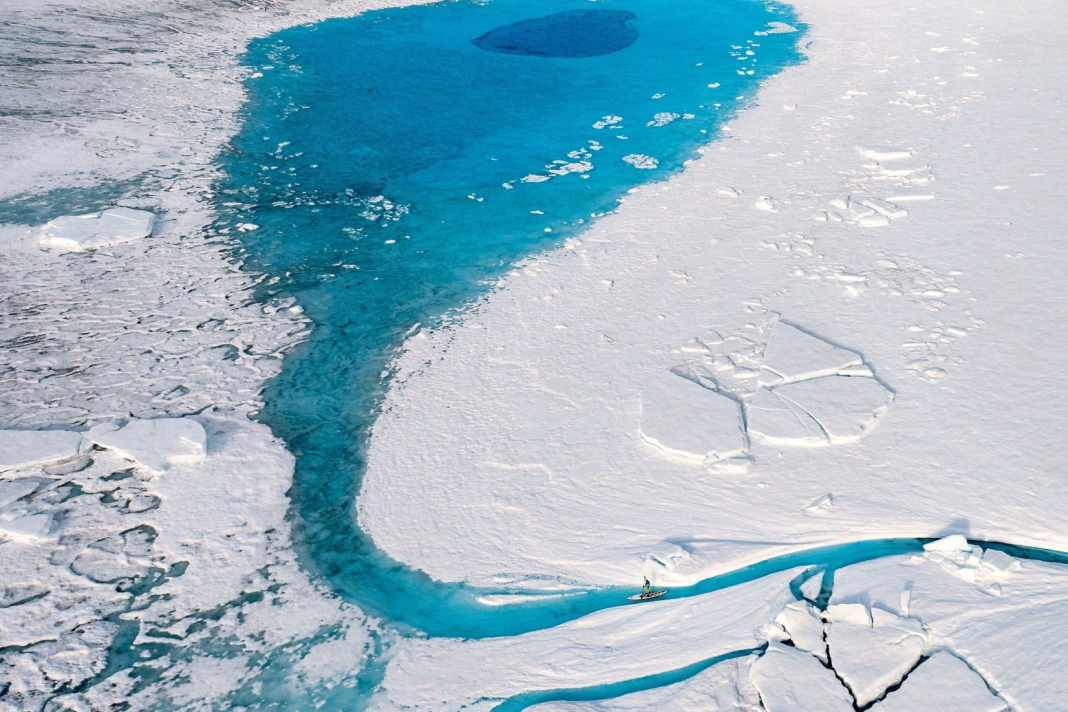





I stare at the seemingly endless ice slope rising up in front of us and ask myself whether I have a good or bad feeling about it. Answer: I have no feeling at all. As we tie figure-of-eight knots in our harnesses, my hand keeps wandering to my nephew's little brown toy horse, which I carry in my trouser pocket as a lucky charm. I'm actually used to assessing risks, especially on the water. But I have no experience of the risks on ice and this uncertainty is frightening. We are very remote, in a place where crevasses and moulins are a real danger - there is no room for error here.
As we slowly begin our ascent, the ground crunches beneath our climbing irons. I stop on the crest of the hill and look at the landscape that spreads out before me: a plateau of white, of ice and snow, as far as the eye can see. Immeasurable, pure and incomparable to anything I've ever seen before.
Then, a breathtaking sight. We stop, we are really here - after years of planning and hoping, the lake lies before us, overwhelming in its azure-coloured tranquillity and like an apparition that seems to exist only in this moment and only for us.
Paddling 450 kilometres in the eternal egg
On this day, we have already completed more than half of our Greenland adventure, during which we paddle 450 kilometres from Upernavik to Kullorsuaq - without an aid convoy. The aim is to document our discoveries along the way, but also to search the ice sheet for the legendary, hard-to-reach ice lakes and to share our experiences with others.
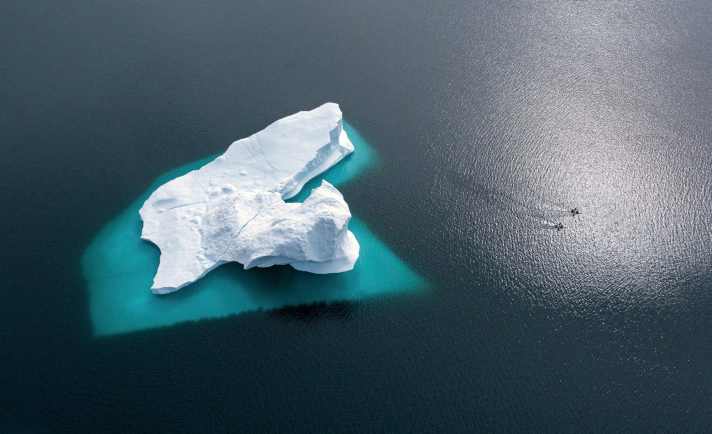
Until this trip, I had never responded to a personal advert, let alone one from three photographers who were looking for a female companion - for a month-long excursion in the eternal ice in an inhospitable country. The three men had been working on the preparations for this trip for three years. In 2021, just five days before their planned departure, their flights were cancelled due to Covid. Justin and Jean-Luc are members of the PlanetVisible photography collective, which aims to discover and document remote places and share their experiences with the public. For both of them, Greenland was a long-cherished dream that was realistic and within reach for quite some time. The third member of the team is Pascal Richard, also a photographer and a long-time friend of both of them.
I didn't really believe I would have a chance to go on this trip, but in March I was actually selected to complete the team as a journalist. We had our first face-to-face meeting in May, a weekend we spent paddling and doing glacier safety training. In July, the time had come and we were waiting at Copenhagen airport for the second of four flights that would take us to our starting point for the SUP adventure.
Greenland is very sparsely populated
Greenland, the largest island in the world, is about six times the size of Germany at 2.16 million square kilometres and has just 56,000 inhabitants. There are no roads or railways, instead there are dogsleds, kayaks, snowmobiles and fishing boats, and the polar bear still reigns supreme. It's interesting how, within 24 hours, you can go from a hot shower in a cosmopolitan capital to a tiny kiosk at 72 degrees longitude and find yourself in a discussion with three people you didn't know until recently, all centred around buying the right gun.
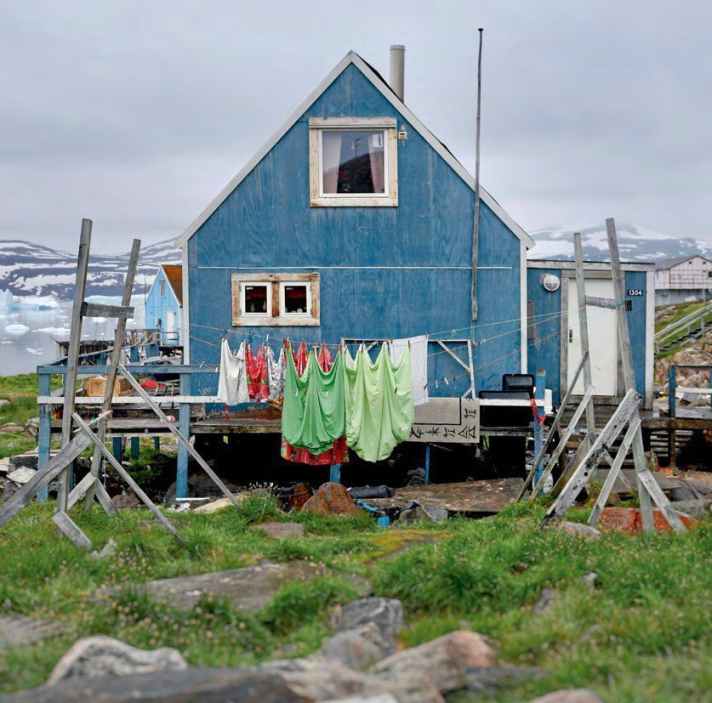
We set off without incident, equipped with our SUPs, which, in addition to the rifle we have just purchased, also have to carry all of our luggage, which weighs more than 230 kilograms. For the first 14 days on our way north, we navigate through the almost uninhabited archipelago of Upernavik, where we also camp in the wild. Loading and unloading the boards takes longer than expected, but we quickly establish a routine. One evening at the beginning of our trip, we organise a training session with the rifle. BANG! We aim and shoot at an iceberg. It's fun, but the idea of encountering a polar bear on the ice or even in the water is also unsettling. Would we even have enough time to get the rifle out of its pocket? Even if encounters of this kind are rather unlikely at this time of year, they do happen - after all, the landscape is constantly changing and the natural habitat of polar bears is becoming ever smaller.
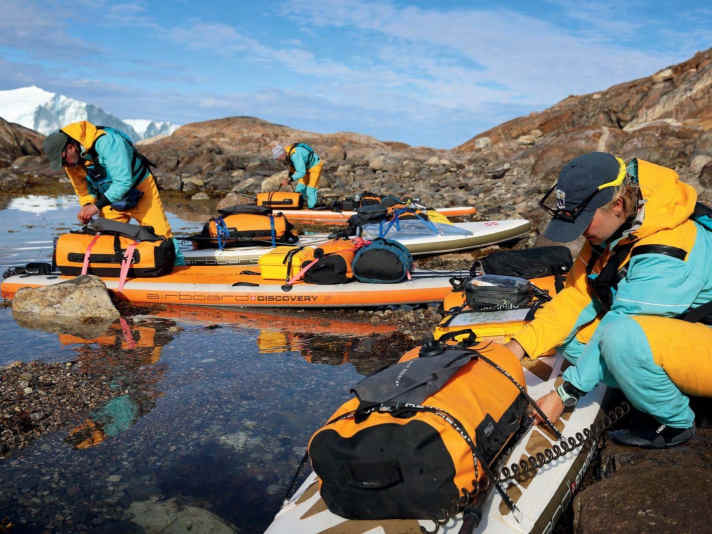
We paddle quickly and only stop to hide from the aggressive 30-knot winds. Day after day, we cover a distance of 20 to 30 kilometres in seven to ten hours, stopping only to take photos (the boys) and to eat (mostly me). We experience a strong camaraderie and I form a special bond with each of the three of them. The conditions can be quite challenging, the water temperature is just above zero degrees - you don't want to fall in. Even a minor injury out here could have serious consequences.
The wind is unpredictable
The wind is unpredictable and less and less often on our side. Paddling is sometimes a real struggle. I'll never forget how we had to fight an aggressive headwind for three hours on our very first afternoon rounding Upernavik, in waters that felt as viscous and thick as syrup. As I pushed my paddle with all my might into the rough, blue-grey sea, trying to keep my balance with as wide a stride as possible, I cursed and wondered how on earth I was going to survive a whole month of this. In fact, I wondered why I was even standing on a paddleboard and why I was doing this madness to myself - just to feel better? Freshly caught cod for dinner, followed by a wonderful night's sleep under the midnight sun - but these thoughts were soon dispelled so that I was ready for another round of adventures the next morning. The vastness and wilderness we face is hard to ignore and it's hard not to enjoy it.
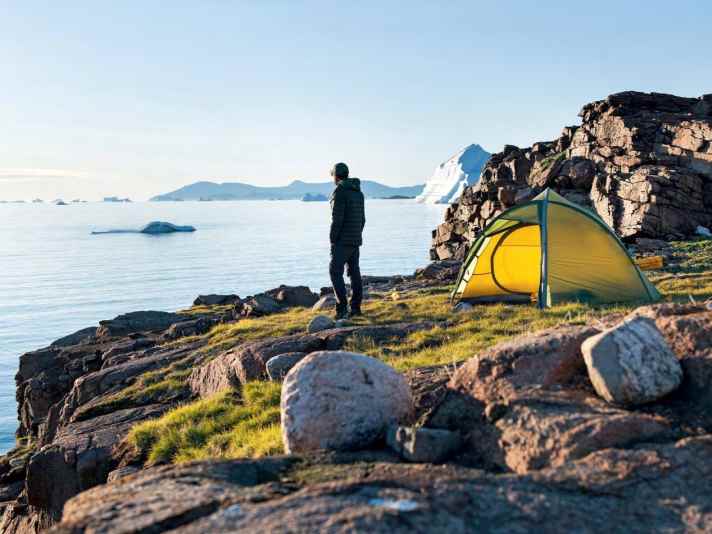
The area we find ourselves in seems almost extraterrestrial and as if it had sprung from a play by Tolkien. Ice plays the leading role and every day amazes us with constantly new frozen shapes. Ruined towers and crooked spears rise from the dark blue depths and make us feel very small. Huge ice surfaces, bigger than a sports stadium, surround us. Paddling between them increasingly feels like a round of "Ochs am Berg" - you want to get close enough to inspect the sheer scale and proportions at close quarters, but at the same time keep enough distance so as not to feel the consequences of a sudden, thunderous fall up close.
Icebergs appear alive through the sounds
For me, the sounds that the ice formations make are unforgettable: they breathe, they drip, they yawn and groan. The booming, thunder-like rumble that echoes between the individual land masses reminds us that nature's greatest shape-shifters are collapsing in close proximity. A choppy crack usually heralds the breaking off of a mighty piece of ice, causing a metre-high wave that fortunately recedes as quickly as it emerged. When this happens, the ice shards crackle like rice crackers. Unpredictable beasts that stagger and tumble, spinning in a matter of seconds.
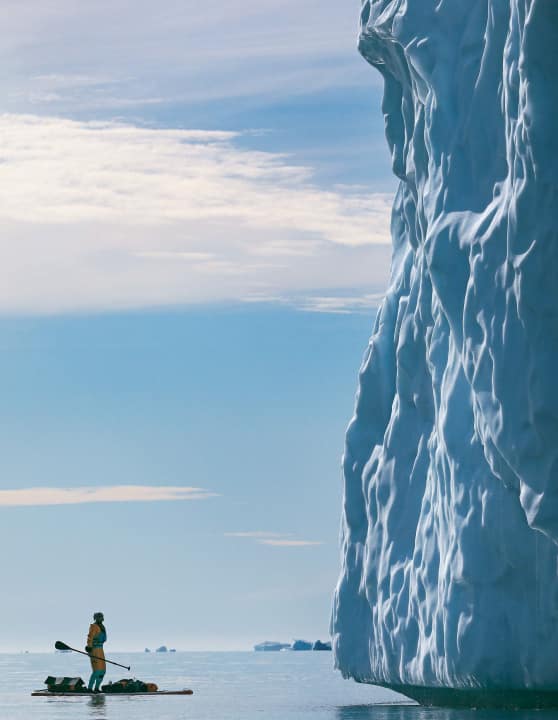
However, not all icebergs along our route resemble ferocious giants. We also pass a number of fjords that are seven or more kilometres wide and full of broken ice and massive lumps of every imaginable shape and size. We have to make our way through them to get to the other side, constantly taking care to avoid those chunks of ice that look like they're going to topple over or tip into the water at any moment. The polar bear jokes increase on such stretches as we nervously scan the surroundings for possible tracks.
The ice lake high above the sea
And now we are standing 600 metres above sea level on the shores of an ice lake, full of awe, enthusiasm and amazement. This is the other half of the dream: to climb the surface of the ice and discover one of the largely unknown meltwater lakes. They form on the surface of the ice in summer and reach diameters of several kilometres and depths of several metres. Their formation depends on temperature, topography and altitude and they can store vast quantities of fresh water for months, which can drain away and disappear within a few hours. Their increased occurrence is - unsurprisingly - due to advancing climate change.
The lake that stretches out before us in the snow is only fed by a small trickle of water that makes its way from the shore through the depths of the water to find an outlet into the sea. We stand at a safe distance from the body of water and analyse a round shape that seems to sit in its centre like an ominous blue speech bubble.
"Who dares to go out on the water?" asks Jean-Luc hesitantly.
"Me," I say.
The answer came instinctively. We had come all this way, had climbed for hours over rocks and ice to get here. It was her dream. I'm not a photographer, so it makes sense for me to venture out so they have someone to capture in their pictures. So I march towards the lakes on my board, sinking more into the mud and ice with each giant step, sometimes up to my thighs. I always keep an eye on the strange cobalt blue porthole, which looks like a cave-like crater.
I reach the shore, climb onto the board as if by remote control and push myself off. I slowly pull my paddle through the calm water beneath me. The sun breaks through the clouds and I feel the energy electrifying me. I feel like the luckiest person on the planet and experience a particularly spiritual moment. It's one of those moments that I know will shape my life.

We jubilantly set off on our descent.
The terrain is challenging - among other things, we have to cross a river and climb over several rocks. We feel soaked moss and loose stones under our feet. It's a constant battle that requires our full attention if we don't want to slip, lose our footing, fall or sprain our ankles. I can hardly wait to get back on the board.
Vital routine
The last week takes us northwards, through even more ice and along rocky islands that sink under more and more snow and become steadily steeper. Our days are characterised by a certain routine: We eat breakfast, pack up camp, squeeze into our banana-yellow drysuits and soaked boots, fill our water bottles and snack bags, load the boards and secure everything before setting off into the unknown for another spectacular day.
Our route is blocked twice by huge masses of pack ice, so we have to change our route and paddle around several peninsulas. Not only does this add kilometres to our journey, but we are also exposed to the open sea on one side. The landscape, a mixture of lichen-covered rocks and snow-capped peaks, is barren and unforgiving. It is impossible not to be intimidated by the remoteness in which we find ourselves.
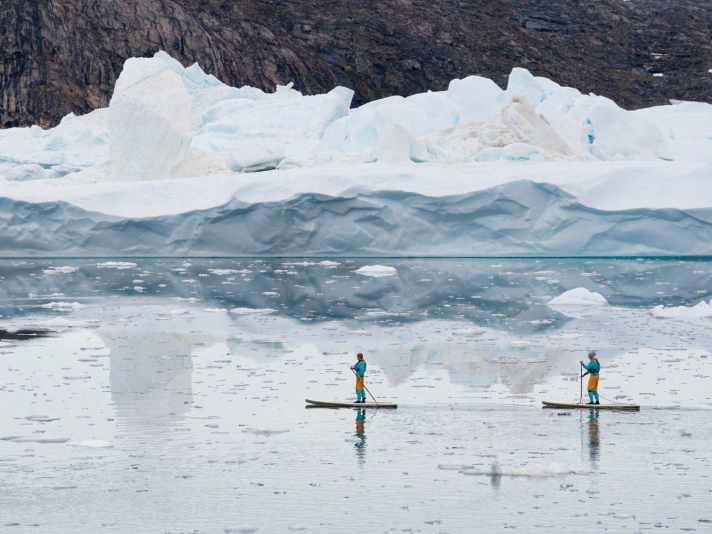
Unfortunately, we don't see any whales. What we do see (and occasionally startle) are numerous ducks with their young. We see lots of birds, including the North Atlantic fulmar, and towards the end of our journey, Arctic terns. The way they fly between and around us and dive down again and again is reminiscent of large, white swallows. The encounter with a sleeping seal was particularly memorable for me. Jean-Luc and I paddled towards it and thought it was dead until we saw a few bubbles rising. The seal looked at us, startled and wide-eyed, before disappearing into the safe depths of the water with a dramatic gesture at lightning speed.
Learn English via YouTube
The only people we meet on the water are fishermen in search of seals or halibut. While the former are shot with a rifle, the Greenlanders catch the latter with a fishing line that can be up to 500 metres long. At the beginning of our trip, we met some young fishermen from Nuussuaq, a small town with fewer than 200 inhabitants, which we would visit after 20 days on the water. Impressed by their knowledge of English in a country where it is not the official language, we asked where they had learnt it.
"From YouTube and films", "I love 'Dark Knight'". It's amazing how much the internet has changed and continues to change the world.
Greenland is a land of extremes
We paddle to Kullorsuaq, in a subdued mood but happy to arrive. The northernmost settlement in the Upernavik archipelago was founded in 1928 and, with a population of around 450, is still one of Greenland's most traditional hunting and fishing communities. While we wait at the heliport for our helicopter to Upernavik, we are told that it is no longer coming. Later we learn from the pilot that it was only ten kilometres away, but thick fog made it impossible to land. As a result, we are stuck for another four days before we can start our journey home, never knowing when the time will come - a real test of patience for each and every one of us. It's also a lesson in control for me, which shows me how much we've become accustomed to having control over our daily lives. But nature is in charge here: the landscape and the forces of nature determine life and humans are small and insignificant.
Greenland is a land of extremes. There is either daylight or darkness for months on end.
The biggest paradox for me is that what could kill you also keeps you alive. Environments like this sharpen our synapses.
Ice, snow and extreme cold characterise everyday life. The biggest paradox for me is that what could kill you also keeps you alive. Environments like these sharpen our synapses. They remind us that our minds are conditioned to help us survive. Out here, risks must be weighed against potential rewards every day. The hostile landscape requires vigilance and keeps the inner fire burning. It is addictive and a reason to leave your comfort zone and experience the thrill that only extreme conditions make possible.
In doing so, we learn to feel comfortable in discomfort.
And that's why I answered the advert, why I needed a trip like this: to allow myself to feel that my energy is fully challenged and depleted. To quiet the roaring noise of daily life, to find absolute silence, to switch off unwanted noises. At the beginning of our journey, Jean-Luc mentioned a saying that his father used to quote: "It is better to know where you are without knowing where you are going, than to know where you are going without knowing where you are."
